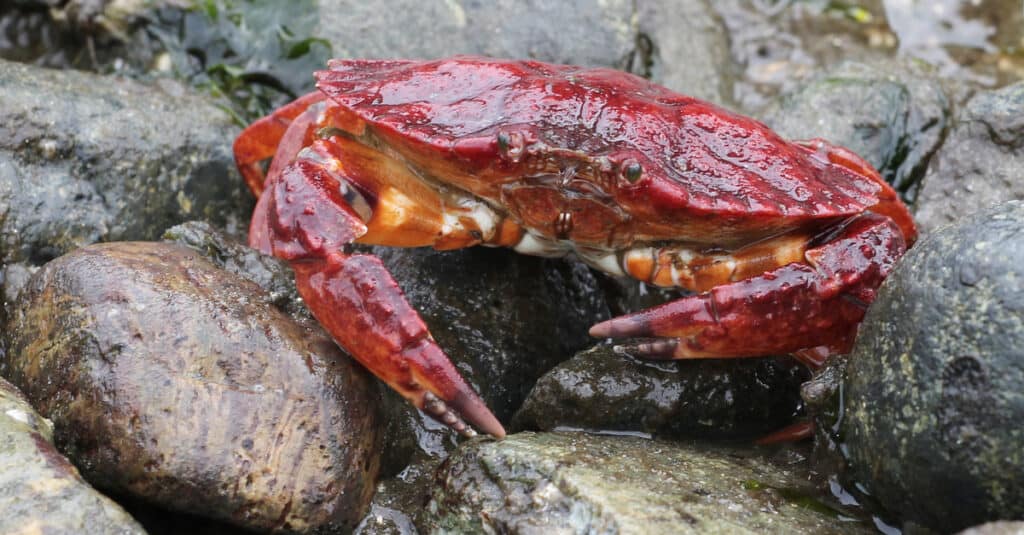Located on the Pacific coast of Washington State, the Puget Sound is home to a vibrant array of marine life, including whales, dolphins, and many species of fish. The sediment layer at the bottom of the sound provides a habitat for creatures like crabs, octopuses, sea urchins, and oysters. Crabbing is a popular activity at the Puget Sound, with sport fishers bringing in over 1.5 million pounds of Dungeness crabs each year. If you’re setting out in hopes of catching some crabs, there are regulations you should know that protect crab species against overfishing.

The Puget Sound has an average depth of around 230 ft., although it reaches nearly 900 ft. at its deepest point.
©GeorgeColePhoto/Shutterstock.com
Understanding the Regulations
The Washington Department of Fish and Wildlife sets the requirements for crabbing in the Puget Sound. The agency requires that crabbers carry a shellfishing license with a crab endorsement in addition to a Dungeness crab Catch Record Card.
Along with Dungeness, crabbers can also catch red rock crabs and tanner crabs. The Department of Fish and Wildlife establishes regulations for each species, including size and collection limits based on the marine area where they’ve been trapped.
The table below includes information for the winter 2023 crabbing season for the marine areas located in Puget Sound. Crabbers must release softshell crabs back into the ocean in all marine areas.
| Marine Area | Location | Species | Season |
|---|---|---|---|
| 4 | Neah Bay-East of Tatoosh-Bonilla line | Dungeness, Red Rock, Tanner | Oct. 1-Dec. 31 |
| 4 | Neah Bay-West of Tatoosh-Bonilla line | Dungeness, Red Rock | Crab pots: Dec. 1-Sep. 15 Other Gear: Year-Round |
| 5 | Sekiu and Pillar Point | Dungeness, Red Rock, Tanner | Oct. 1-Dec. 31 |
| 6 | East Juan de Fuca Strait, Port Angeles Harbor, Discovery Bay | Dungeness, Red Rock, Tanner | Oct. 1-Dec. 31 |
| 7 | South – San Juan Islands/Bellingham | Dungeness, Red Rock, Tanner | Oct. 1-Dec. 31 |
| 7 | North – Gulf of Georgia | Dungeness, Red Rock, Tanner | Oct. 1-Dec. 31 |
| 8-1 | Deception Pass | Dungeness, Red Rock, Tanner | Oct. 1-Dec. 31 |
| 8-2 | Port Susan/Everett | Dungeness, Red Rock, Tanner | Oct. 1-Dec. 31 |
| 9 | Admiralty Inlet | Dungeness, Red Rock, Tanner | Oct. 1-Dec. 31 |
| 10 | Seattle/Bremerton | Dungeness, Red Rock, Tanner | Closed for Winter 2023 |
| 11 | Tacoma-Vashon Island | Dungeness, Red Rock, Tanner | Closed for Winter 2023 |
| 12 | Hood Canal – North of Ayock Point | Dungeness, Red Rock, Tanner | Oct. 1-Dec. 31 |
| 12 | Hood Canal – South of Ayock Point | Dungeness, Red Rock, Tanner | Closed for Winter 2023 |
| 13 | South Puget Sound | Dungeness, Red Rock, Tanner | Closed for Winter 2023 |
Daily Limits for Dungeness, Red Rock, and Tanner Crabs
The Washington Department of Fish and Wildlife limits the number of crabs that can be caught each day, as well as what size the crabs must be.
- Dungeness crabs: Limited to five males per day with a size of at least 6.25 inches.
- Tanner crabs: Limited to six per day, male or female, with a size of at least 4.5 inches.
- Red rock crabs: Limited to six per day, male or female, with a size of at least 5 inches.

Dungeness Crabs typically prefer shallower waters but can also be found at depths of one hundred feet or more.
©Jennifer Nicole Buchanan/Shutterstock.com
Harvesting Methods
Dungeness crabs can be found along the bottom of Puget Sound, where they live on the sea floor, feeding on small fish, clams, oysters, and mussels. Red rock crabs generally stick to rocky areas over sandy or muddy areas.
The favored method for many crabbers is to set traps in deeper waters from a boat. However, crabbers are also permitted to catch crabs by wading into the water with a dip rake or dip net and by casting devices from a pier with a fishing pole.
It is illegal to catch crabs using poison, chemical irritants, or methods that pierce the crab’s shell. It is also illegal to set or retrieve traps from a boat more than one hour before the sun rises or more than one hour after it sets.
How to Prepare Traps, Buoys, and Lines
Crab traps — also known as crab pots — and ringnets are available in different styles and designs. However, they must all meet the following requirements:
- The mesh size must be a minimum of 1.5 inches.
- The trap’s volume must not exceed 13 cubic feet.
- The trap must have two escape rings for smaller crabs at least 4.5 inches in diameter.
- The trap must include an escape cord made of natural and biodegradable fiber.
A crabber’s gear setup should include a crab pot, a sinking line (or a line plus a line weight), and a red-and-white buoy that is marked with your full name and address. Floating line is more likely to get caught in boat propellers, resulting in lost crab traps. Each crabber is limited to two sets of gear.
Before setting out for the season, check your traps to ensure they are free from large holes, the entrance gate is operational, and the escape cord is intact.

Crabbing gear includes a crab pot, a sinking line, and a floating buoy.
©Ashley-Belle Burns/Shutterstock.com
How to Bait and Set Traps
Long-time crabbers each have their preferred types of bait. Popular choices include clams, squid, fish carcasses, and chicken. When choosing a bait container for your trap, make sure water can flow around the bait and carry off its scent.
The tides can cause large differences in the water’s depth, which you’ll need to consider when measuring the amount of line you’ll need from your floating buoy to your trap on the sea floor.
Try to avoid setting your traps in areas with strong currents or high boat traffic. If you have lighter traps, try adding weight to ensure they’re not swept away. You can also add an extra buoy to make your crab pot easier to spot. Lost pots will continue to trap crabs, which results in unnecessary crab deaths.
How to Measure and Sort
The Washington Department of Fish and Wildlife requires crabbers to sort and measure crabs. Female Dungeness crabs must be returned to the water, along with undersized males and softshell crabs. To identify male from female Dungeness, check the crab’s abdomen. Females have wider abdominal flaps, while the flaps on males are much narrower.
Calipers are available to make it easier to measure, or you could make notches along your boat to decrease the chances of getting pinched. Measure the top of the shell at the widest point, excluding the tips of the shell points. Be sure to release crabs back into the water gently, using a bucket and line if needed.

Measure crabs across the widest point of their shell, but do not include the tips of their shell points.
©CybersoftMTL/Shutterstock.com
How to Record Your Catch
If you’re crabbing in Puget Sound, you only need to record Dungeness crabs. It is not necessary to keep a record of red rock crabs or tanner crabs. Use your Catch Record Card (CRC) to keep track of the marine area, date, and how many Dungeness crabs you caught.
How to Transport, Clean, and Cook
Once you’ve sorted and measured your catch, you need to transport your crabs back home. Avoid submerging your crabs in water, since they will use up the available oxygen and die. Instead, keep crabs in a cool, damp environment with a seawater-soaked towel and frozen water bottles or bags of ice.
Crabs must be cleaned before eating. If you prefer to clean your crabs while in the field, save the shells as proof the crab was the right size for harvesting. Use a sharp, heavy tool to strike the crab’s underside and kill it quickly. From there, remove the top shell and split the crab into halves along its midline in order to remove the tail, gills, and viscera.
There are countless recipes for turning your catch into a delicious meal. At the very least, you’ll need to cook your crabs in boiling, salted water for 12-15 minutes.

Red rock crabs molt — a process of shedding their old shell as they grow new ones — several times throughout their lives.
©Randy Bjorklund/Shutterstock.com
How to Report Your Catch
If you’ve been issued a Catch Release Card for crabbing in Puget Sound, the Department of Fish and Wildlife requires that you report your Dungeness crab catch, even if you did not catch any crabs or decided not to try. Check your CRC card for the deadline for when you must report to avoid receiving a penalty on your next crab endorsement.
You can report your catch online by mailing your CRC to the address on the card or by dropping your CRC off at a Washington Department of Fish and Wildlife office.
The photo featured at the top of this post is © Justin Kral/Shutterstock.com
Thank you for reading! Have some feedback for us? Contact the AZ Animals editorial team.







